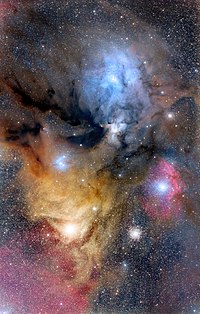へびつかい座ρ分子雲領域ρ Ophiuchi cloud complex
星座
へびつかい座
視直径
4.5° × 6.5°[ 1]
位置元期 :J2000.0
赤経 (RA, α)
16h 28m 06s [ 2]
赤緯 (Dec, δ)
–24° 32.5′[ 2]
距離
460 光年 (140 パーセク ) [ 3]
他のカタログ での名称
へびつかい座分子雲、Integral 691、XSS J16271-2423
■ Template (■ ノート ■ 解説) ■Project
へびつかい座ρ分子雲領域 (へびつかい座ロー分子雲領域)は、へびつかい座ρ星 の南約1度のところに位置するガスとダストからなる暗黒星雲 の複合体である。太陽系 からの距離は131 ± 3パーセクと見積もられており[ 3] [ 4] 星形成領域 の一つである[ 5]
この分子雲 領域は天球 上の4.5度×6.5度の領域を占めており、2つのガス・ダストが濃密な部分に分けられる。一つは星形成分子雲L1688と2つのフィラメントL1709, L1755を含み、もう一つは星形成領域L1689とフィラメントL1712–1729を含んでいる。これらのフィラメントは幅にして0.24パーセクあり、その長さは10–17.5パーセクにわたる。この分子雲複合体の構造には、隣接するSco OB2 アソシエーション の方向から分子雲を通過する衝撃波面 によって生じているものもある[ 1]
領域内の分子雲の温度は13–22Kであり、太陽質量 の3,000倍もの物質が存在している。この質量の半分以上はL1688分子雲周辺に分布しており、この分子雲複合体の中で最も活動的な星形成領域となっている[ 1] 赤外線源 を擁しており[ 6] 若い星状天体 であると考えられており、そのうち16個は原始星 、123個は濃密な星周円盤 を伴うTタウリ型星 、77個は希薄な円盤を伴う弱輝線Tタウリ型星 に分類されている[ 3] [ 7]
最初に星形成領域の中に見出された褐色矮星 はRho Oph J162349.8-242601であり、これはへびつかい座ρ分子雲領域で見つかったものである[ 8] [ 9] 木星質量 の2倍もの物質を含んでいる。円盤の中心星は数百万年の年代を示し、表面温度は3,000K、光度 は太陽のそれの0.4倍である[ 10]
^ a b c Loren, Robert B. (March 15, 1989). “The cobwebs of Ophiuchus. I - Strands of (C-13)O - The mass distribution”. Astrophysical Journal, Part 1 338 : 902–924. Bibcode : 1989ApJ...338..902L . doi :10.1086/167244 .
^ a b “RHO OPH REGION -- Molecular Cloud ”. SIMBAD . Centre de Données astronomiques de Strasbourg. 2009年10月24日 閲覧。
^ a b c Bontemps, S. (June 2001). “ISOCAM observations of the rho Ophiuchi cloud: Luminosity and mass functions of the pre-main sequence embedded cluster”. Astronomy and Astrophysics 372 : 173–194. arXiv :astro-ph/0103373 . Bibcode : 2001A&A...372..173B . doi :10.1051/0004-6361:20010474 .
^ Mamajek, E.E. (2008). “On the distance to the Ophiuchus star-forming region”. Astronomische Nachrichten 329 : 10–14. arXiv :0709.0505 . Bibcode : 2008AN....329...10M . doi :10.1002/asna.200710827 . ^ “Young Stars in Their Baby Blanket of Dust ”. Spitzer Multimedia Features . NASA (2008年11月2日). 2009年10月24日 閲覧。 ^ Wilking, B. A.; Lada, C. J. (November 15, 1983). “The discovery of new embedded sources in the centrally condensed core of the Rho Ophiuchi dark cloud - The formation of a bound cluster”. Astrophysical Journal, Part 1 274 : 698–716. Bibcode : 1983ApJ...274..698W . doi :10.1086/161482 . ^ Luhman, K. L.; Rieke, G. H. (November 1999). “Low-Mass Star Formation and the Initial Mass Function in the ρ Ophiuchi Cloud Core”. The Astrophysical Journal 525 (1): 440–465. arXiv :astro-ph/9905286 . Bibcode : 1999ApJ...525..440L . doi :10.1086/307891 . ^ Martín, E. L. (2001). Hugh R. A. Jones; Iain A. Steele. eds. Spectroscopy of Young Brown Dwarfs and Isolated Planetary Mass Objects 153–167 . ISBN 3-540-42353-2 . https://archive.org/details/ultracooldwarfsn0000unse/page/153 ^ Rieke, G. H.; Rieke, M. J. (1990-10). “Possible substellar objects in the Rho Ophiuchi cloud” (英語). The Astrophysical Journal 362 : L21. doi :10.1086/185838 . ISSN 0004-637X . https://adsabs.harvard.edu/doi/10.1086/185838 . ^ Grosso, Nicolas (May 7, 2002). “Infrared Images of an Infant Solar System ”. Press Releases . European Southern Observatory . 2009年10月25日 閲覧。


